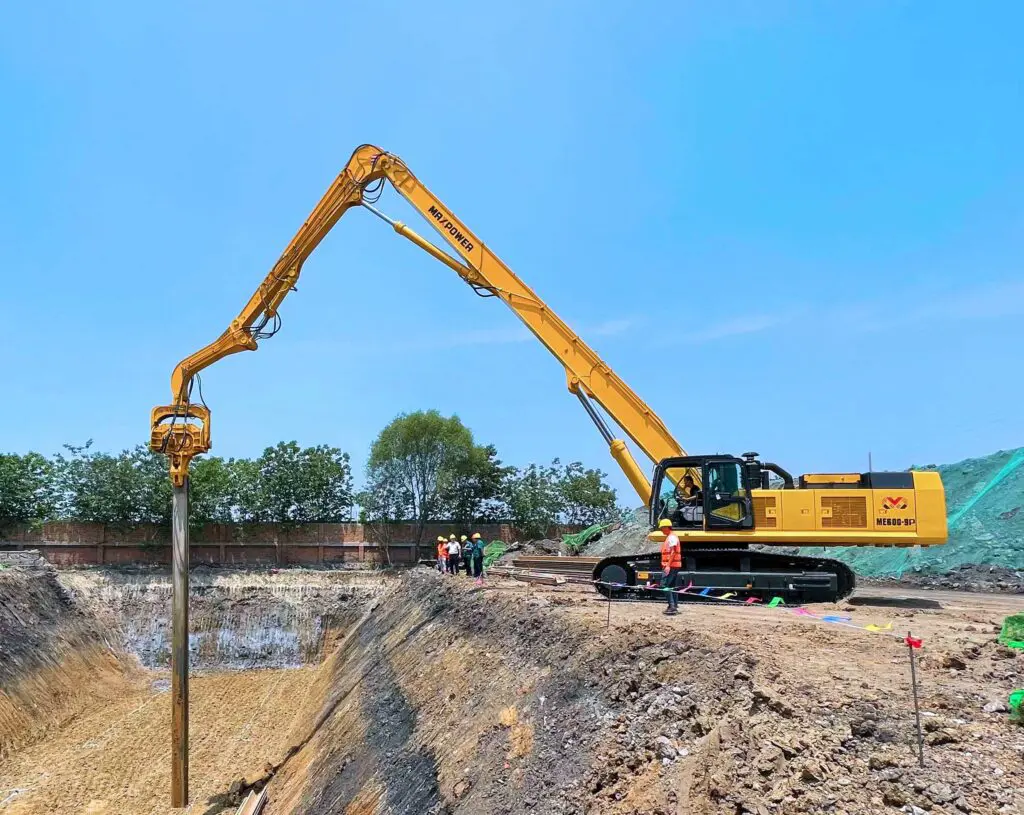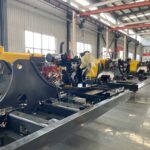Introduction
Rotary drilling rigs have become an indispensable piece of machinery across a wide range of industries. With their versatile drilling capabilities, rotary rigs are utilized for everything from constructing buildings and infrastructure to exploring for oil, gas, minerals and groundwater. In this post, we will explore the diverse applications and uses of rotary drilling rigs, focusing on how they enable important work in construction, mining, geotechnical engineering and resource exploration.
Common Components and Operating Principles

Before delving into specific uses, it is helpful to understand the basic components and operating principles of rotary drilling rigs. At their core, rotary rigs consist of a mast or derrick mounted on a carrier that provides support and mobility. The mast supports a rotary table that spins drill pipe and drill bits to facilitate drilling. Drill pipe runs from the rotary table down through the drill floor and into the borehole. A drawworks powers the hoisting of drill pipe in and out of the hole. Other common components include a mud system to flush cuttings from the borehole, a top drive to turn the drill string, and control systems to automate and monitor drilling operations.
Rotary drilling works by rotating a drill bit at the bottom of the drill string while applying downward pressure. As the bit cuts into the rock or soil, drilling fluid is pumped through the inside of the hollow drill pipes to the bit. The fluid lubricates and cools the bit while flushing cuttings back to the surface for disposal. Rotating and feeding downward, the bit gradually deepens the borehole – a versatile drilling technique applicable to a wide range of industries, as outlined below.
Uses in Construction
One of the most common uses of rotary drilling rigs is in construction applications such as foundation installation, soil investigation, and underground utility installation. Small to mid-sized rigs are well-suited for tasks like:
- Drilling piers, caissons and pile foundations for buildings and bridges. Rotary drilling efficiently bores holes that concrete or steel pilings are placed into for structural support.
- Installing drilled shafts for retaining walls, noise barriers and sign structures. Drilled shafts provide a deep, stable foundation alternative to spread or strip footings.
- Conducting geotechnical test borings to characterize subsurface soil and rock conditions for engineering design. Data from samples and downhole testing aids site evaluation.
- Installing underground utilities like pipes, conduits and cables. Drilling enables trenchless installation that avoids excavation hazards and surface restoration.
- Dewatering construction sites through installation of vertical wells for pumping groundwater. This allows for dry excavations and reduces hydrostatic pressure on retaining structures.
| Construction Application | Typical Size Ranges of Rigs Used |
|---|---|
| Foundation Drilling | Small to Large |
| Piling | Medium to Large |
| Excavation | Small to Large |
| Retaining Wall Construction | Medium to Large |
| Bridge Construction | Large |
| Tunneling | Large |
| Road Construction | Medium to Large |
| Dam Construction | Large |
| High-Rise Building Foundation | Large |
| Soil Stabilization | Small to Medium |
Uses in Mining and Mineral Exploration

Rotary drilling rigs play an indispensable role across the mining industry, from mineral exploration to production drilling. Key applications include:
- Exploration drilling: Rig-mounted diamond core drills recover continuous rock core samples to map ore bodies and geology. Core provides critical data to guide exploration programs.
- Definition drilling: Used to further delineate ore deposits and establish resource estimates. Tighter drill spacing helps classify resources as measured, indicated or inferred.
- Grade control drilling: Conducted to map variations in ore grade within deposits, guiding selective mining approaches.
- Blasthole drilling: Larger rigs rapidly drill patterns of holes that are loaded and blasted to excavate rock in surface and underground mines.
- Dewatering: As with construction, rigs install vertical dewatering wells to lower water tables and keep mines dry during production.
- Underground production drilling: Specialized rigs equipped with boom systems drill from underground workings to extend mining to new areas.
The mining sector relies on rigs from small track-mounted explorers to massive 300-ton production machines. Their drilling capabilities are essential for cost-effectively finding and extracting mineral resources.
Uses in Oil, Gas and Geothermal Exploration
Perhaps the application most associated with rotary drilling rigs is exploration and production in the petroleum and geothermal industries. Key uses involve:
- Exploration and appraisal drilling: Rig-based coring and wireline-logging helps map prospective formations and locate hydrocarbon or geothermal reservoirs.
- Development and delineation drilling: Closer well spacing to define field extents, reservoir characteristics and production potential.
- Production drilling: Installation of vertical, directional and horizontal wells to efficiently produce oil and gas or access geothermal reservoirs.
- Injection and disposal wells: Used for waterflooding, steam injection, hydraulic fracturing, wastewater disposal and enhanced geothermal system projects.
- Geotechnical site investigations: Common in siting and permitting of energy projects to understand subsurface conditions.
Rig capabilities like mobility, power, hoisting, automation and advanced well control enable the complex drilling programs required for these energy-related applications. Sizes range from mobile shallow-depth heaters to multi-million dollar offshore ultra-deepwater rigs.
Uses in Geotechnical and Environmental Engineering
Beyond construction and mining/energy sectors, rotary rigs support critical geotechnical and environmental engineering applications:
- Site characterization: Used for pre-development subsurface exploration and mapping of soil/rock formations, groundwater, contamination etc.
- Slope stability analysis: Installing instrumentation in boreholes to monitor slope movements, pore pressures and establish failure mechanisms.
- Retaining wall and foundation design: Delineating soil profiles and obtaining samples/tests to properly size and engineer earth-retaining structures.
- Ground improvement: Drilling patterns and installing elements like stone columns, grout columns and drains to stabilize weak soils before construction.
- Remediation: Installing groundwater extraction, injection and monitoring wells for environmental reclamation projects.
- Geothermal applications: Used in direct-use and ground-source heat pump projects to install vertical ground loop heat exchanger fields.
Across these geotechnical and environmental applications, rigs provide a means to access the subsurface realm and gather vital engineering data through drilling and sampling.
Conclusion: uses of rotary drilling rig
In summary, rotary drilling rigs have become indispensable machinery serving diverse applications and industries. Their versatile drilling capabilities have enabled important work in construction, mining, energy, geotechnical engineering and environmental projects. Whether installing foundations, exploring for resources, installing monitoring wells or improving ground conditions – rotary rigs continue to revolutionize how we interact with and develop the subsurface world. Looking ahead, technological advances will further expand their capabilities and uses into new domains. Rotary drilling rigs exemplify how innovative machinery can enable progress across multiple sectors of the economy and help tackle challenges in engineering and natural resource development.
FAQs
What are the primary applications of rotary drilling rigs?
Rotary drilling rigs are utilized in a variety of industries and applications, including construction, geotechnical exploration, mining operations, environmental remediation, and oil and gas exploration.
How deep can rotary drilling rigs drill?
The drilling depth of rotary drilling rigs can vary depending on factors such as rig size, drilling technique, and geological conditions. However, some rigs are capable of drilling several thousand feet into the earth’s crust.
What types of materials can rotary drilling rigs drill through?
Rotary drilling rigs are versatile machines capable of drilling through various materials, including soil, rock, concrete, and asphalt. They are often equipped with different drill bits and accessories tailored to specific drilling requirements.
What safety precautions should be taken when operating rotary drilling rigs?
Safety is paramount when operating rotary drilling rigs. Operators should undergo proper training, wear appropriate personal protective equipment, and adhere to safety protocols to prevent accidents and injuries. Regular equipment inspections and maintenance are also essential for safe operations.
How do rotary drilling techniques contribute to efficiency and precision in construction projects?
Rotary drilling techniques offer superior efficiency and precision compared to traditional drilling methods. By using rotary motion to penetrate the ground and extract samples, these rigs can achieve accurate drilling depths and angles, ensuring precise construction foundations, piling, and excavation.






-150x150.webp)
